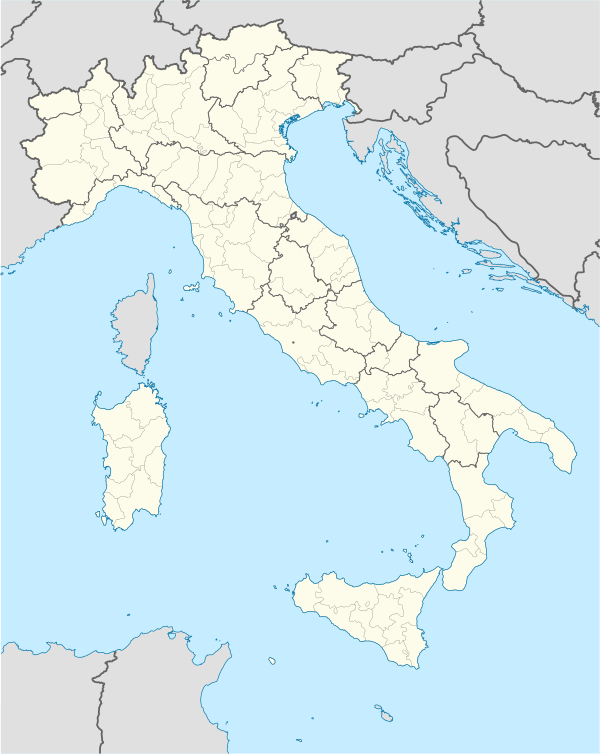Rescaldina
| Rescaldina | ||
|---|---|---|
| Comune | ||
| Comune di Rescaldina | ||
| ||
 Rescaldina Location of Rescaldina in Italy | ||
| Coordinates: 45°37′N 8°57′E / 45.617°N 8.950°ECoordinates: 45°37′N 8°57′E / 45.617°N 8.950°E | ||
| Country | Italy | |
| Region | Lombardy | |
| Province / Metropolitan city | Milan (MI) | |
| Frazioni | Ravello, Rescalda | |
| Government | ||
| • Mayor | Michele Cattaneo (Vivere Rescaldina (left-center)) | |
| Area | ||
| • Total | 8.2 km2 (3.2 sq mi) | |
| Elevation | 220 m (720 ft) | |
| Population (2011)[1] | ||
| • Total | 13,925 | |
| • Density | 1,700/km2 (4,400/sq mi) | |
| Demonym(s) | Rescaldinesi | |
| Time zone | CET (UTC+1) | |
| • Summer (DST) | CEST (UTC+2) | |
| Postal code | 20027 | |
| Dialing code | 0331 | |
| Patron saint | San Bernardo Abate | |
| Saint day | August 20 | |
| Website | Official website | |
Rescaldina is a comune (municipality) in the Province of Milan in the Italian region Lombardy, located about 25 kilometres (16 mi) northwest of Milan.
Geography
Rescaldina borders the following municipalities: Cislago, Gorla Minore, Gerenzano, Marnate, Uboldo, Castellanza, Legnano and Cerro Maggiore. Except for Legnano and Cerro Maggiore, the other municipalities belong to the Province of Varese.
The municipality counts two civil parishes (frazioni): Ravello and Rescalda.
History
Earliest traces of human presence in the area of the present municipality of Rescaldina dates back to the ancient Rome civilization period as demonstrated by a Roman ara (altar) found here. The ara was probably placed aside the main road that run along the Valle Olona (Olona valley) from Milan to Varese. After having stayed for several decades at the entrance of the local cemetery, the ara is now placed in the parish house courtyard.
The first rural settlement (grangia) was probably made by Cistercian monks in the middle age. Two major rural settlements grew in the area: Rescalda and Rescaldina.
Rescaldina was elevated to parish by St Charles Borromeo in 1570 and placed within the Pieve of Legnano. Rescalda inhabitants requested their parish autonomy which was refused. They reacted by self-taxing in order to sustain a priest to guide their community: the parish of Rescalda was then created in 1608 and placed within the Pieve of Busto Arsizio. This method of self-taxing to sustain their priest gave Rescalda inhabitants the right to elect their parson until the Second Vatican Council.
Two building in Rescaldina still show the coat of arms of the Visconti of Milan which support the legend of a summer hunting lodge of the noble family, hence placing Rescaldina under the control of the Duchy of Milan since the XIII century. Although the legend has never been confirmed by documents, it is the basis of the city coat of arms which shows a wolf escaping from the main tower of a castle. It reminds the daring escape of a noble, Lupo da Limonta (Lupo means wolf), who was imprisoned in the tower presently located in via Roma 7, which still shows the Visconti coat of arms. During the fight for power between Visconti and Sforza families, the noble prisoner was helped free by a jester, Tremacoldo, thanks to a ruse. One day Tremacoldo was admitted to a Saracen Joust, but he made it possible to be replaced by Lupo da Limonta dressed up such that no one could recognize him. When the tournament began, instead of heading towards the Saracen target, Lupo run away.
An important family who ruled Rescaldina from the XIV to the XVII century was the House of Lampugnano (or Lampugnani). During that period Rescalda had a population two to three times large than Rescaldina. The House of Melzi based in Legnano used to own a huge amount of land and buildings in the municipality for the last centuries. The Mailänder Kataster (Milanese cadaster) in 1730 showed that the majority of the Rescaldina area was shared among noble families. The 1807 census showed that Rescaldina had a population of 207 people and Rescalda a population of 630; the main occupation was agriculture. During Italian unification Rescaldina and Rescalda were unified as the municipality of Rescaldina.
Economy
Agriculture has been the main occupation of the population until the late XIX century. In 1830 the textile company Bassetti was founded in Milan and in 1840 they created their first plant in the rural village of Rescaldina. The plant quickly developed and from the first decades of the XX century the mechanization of the textile plant induced the full industrialization of the town. At present Bassetti is part of the Zucchi textile group which houses the Zucchi Collection museum in their headquarters in Rescaldina. The museum is considered to be one of the biggest collections of handblocks for printed fabrics in the world.
In the early XX century the Rescaldina railway station was built on the Ferrovie Nord Milano line that joins Saronno and Novara. In 1924 the first toll highway in the world was created, the Autostrada dei Laghi which passes by Rescaldina. Two exits on the A8 branch (Milano - Varese) directly serve Rescaldina, and the nearest exit on the A9 branch (Milano - Como) is just 6 km away. The presence of both the railway and the highway highly contributed to the social and economical development of the town: the easy commuting to Milan boosted the education and job opportunities.
At the end of the XX century Rescaldina experienced the same changes as its wider area (Alto Milanese) i.e. from manufacturing to service industry.
